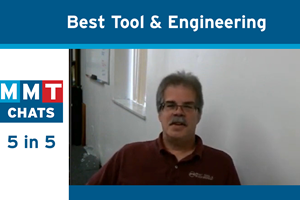Doing the Math on Your Moldmaker's Value
About this series: For those charged with raising the sales of a mold building company, differentiating one’s company from the competition is fundamental. This quarterly series features actual examples of the front-line representative of a mold building company presenting new approaches to improve the customer’s profitability.
A moldmaker likes a challenge, and that is what was received when A-1 Tool Company (Melrose Park, IL) was approached by a West Coast container manufact-urer. The molder had been manufacturing a product for some time and had many molds used for its production, but now there was a desire to alter the molds in order to reduce the part weight due to the rising cost of the plastic material.
Mike Schillaci, Vice President of Sales, related that this customer had previously tried to reduce the wall stock using the current mold design and gating by just reducing the wall thickness of the part. The customer invested time and money on the effort only to see it fail due to flow length. That’s when the customer turned to A-1 Tool.
Having already worked with similar projects, the A-1 team knew that although its customer’s original request for help working with existing tooling was not an impossible one, another approach was viable and so they presented a new solution.
“With this project, we began by looking at aspects including those our customer may not have considered,” explains Schillaci. “With every project, we try to meet with customers early on so that we can influence the part design. Our sales personnel have the experience and skills needed to warn of such things as bad steel condition, drafts needed for textures and changes that could make secondary labor less intense and costly.”
Schillaci and A-1 Tool’s President Geoff Luther met with the customer and reviewed the problem, and then proposed building a new tool—though that was not the original customer request. Questions that were asked:
- “What is the estimated production quantity?”
- “How long do you have to fill the pipeline?”
- “What molding equipment will be used or what is available?”
- “Is automation required or an option?”
“We quoted options on design elements that could influence any tests or shipping requirements they may run into,” Schillaci says.
For example, the thinner wall could fail a drop test, so design options were quoted, such as structural ribbing or reshaping the bottom of the container—changes that could be made with minimal influence on the tool and the customer’s budget.
“Upon initial sampling, if the product doesn’t pass every test, the options we quoted are already budgeted for and therefore can be implemented quickly,” he explains.
Because the original tool could not be effectively altered and saved for production, A-1 Tool’s new approach, given the savings gained over the life of the mold, made the investment in a new tool a savvy financial decision for the customer.
Calculating the Savings
A-1 Tool was able to do the math for its customer (see sidebar) on this project to prove out the savings gained
by implementing a new mold build and these were the results:
- Faster cycle times. This project yielded an impressive 15 percent gain in speed of production.
- Fewer rejects—Structural tests were considered at the design stage and the product met customer requirements, including visual testing (texture or draft issues, etc.) ensuring an aesthetically pleasing, quality molded product.
- Significant material savings over the original mold design: $800,000 per year. The original molds have been
- running for about 10 years and it is expected the new molds will run for at least that long.
“We offered contingencies and provided tangible data that could be taken back to management to justify the idea of not only building a new mold, but for building a better one,” states Luther.
There is nothing more costly than a tool that doesn’t perform to its maximum potential. Producing the lowest cost part is the whole reason a tool is built. Challenging traditional approaches of the past is an opportunity for profitability on the part of both the moldmaker and the customer.
Related Content
Making Quick and Easy Kaizen Work for Your Shop
Within each person is unlimited creative potential to improve shop operations.
Read MoreWomen Impacting Moldmaking
Honoring female makers, innovators and leaders who are influencing our industry's future.
Read MoreMMT Chats: 5 in 5 with Best Tool and Engineering
MoldMaking Technology Editorial Director Christina Fuges reveals 5 best practices for improving efficiencies within shops...in 5 minutes. Our guest is Joe Cherluck, President of Best Tool and Engineering in Clinton Township, Michigan. This episode is brought to you by ISCAR.
Read MoreConsiderations for Mold Base Material Selection
Choosing the right material can greatly affect the profitability and cost of your application.
Read MoreRead Next
How to Use Strategic Planning Tools, Data to Manage the Human Side of Business
Q&A with Marion Wells, MMT EAB member and founder of Human Asset Management.
Read MoreHow to Use Continuing Education to Remain Competitive in Moldmaking
Continued training helps moldmakers make tooling decisions and properly use the latest cutting tool to efficiently machine high-quality molds.
Read MoreReasons to Use Fiber Lasers for Mold Cleaning
Fiber lasers offer a simplicity, speed, control and portability, minimizing mold cleaning risks.
Read More








_300x250 4.png;maxWidth=300;quality=90)






.jpg;maxWidth=300;quality=90)









